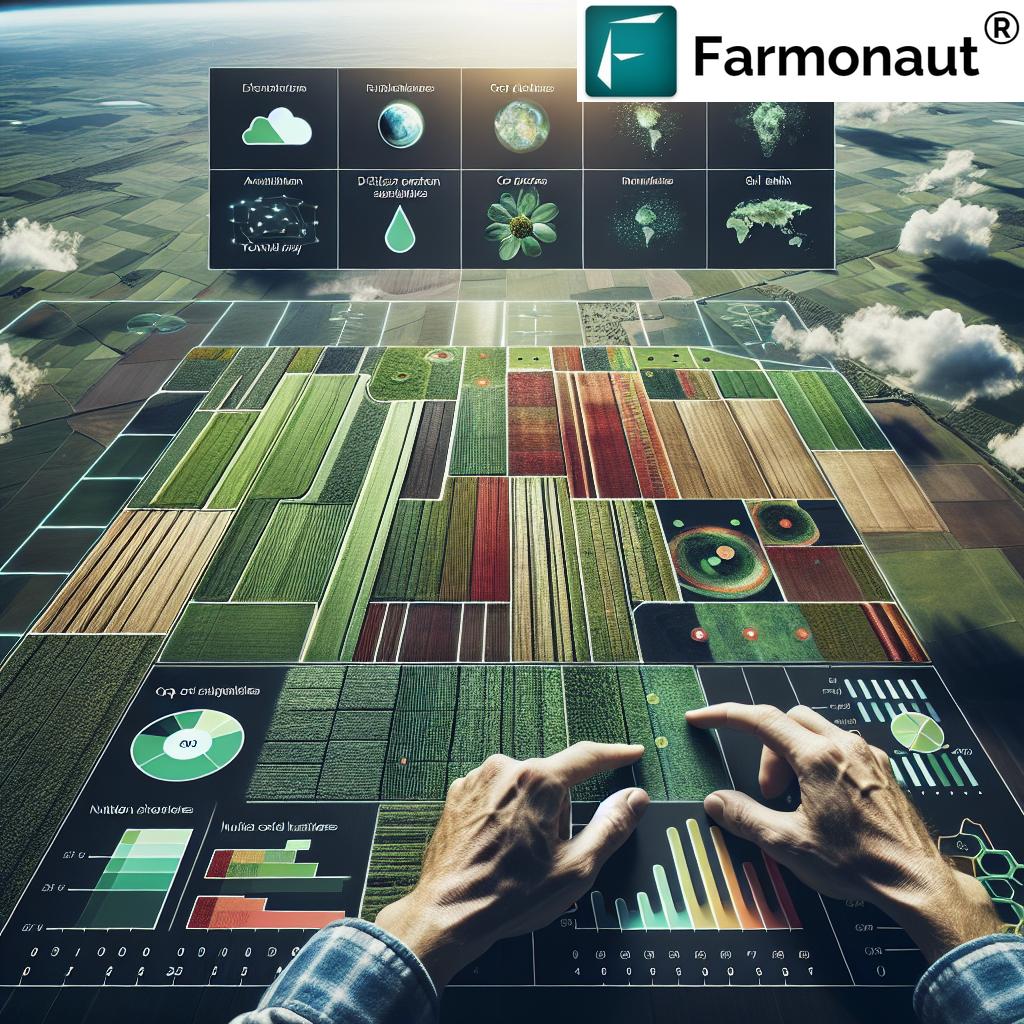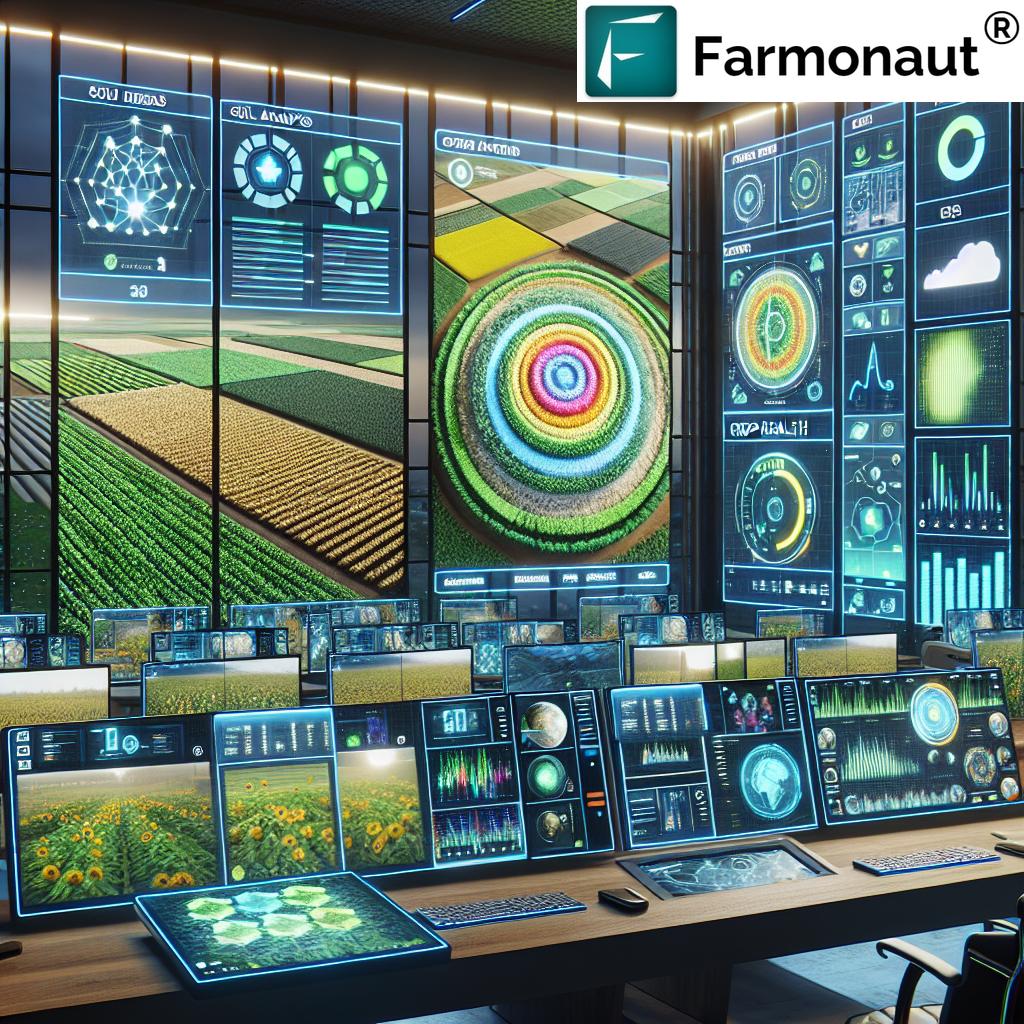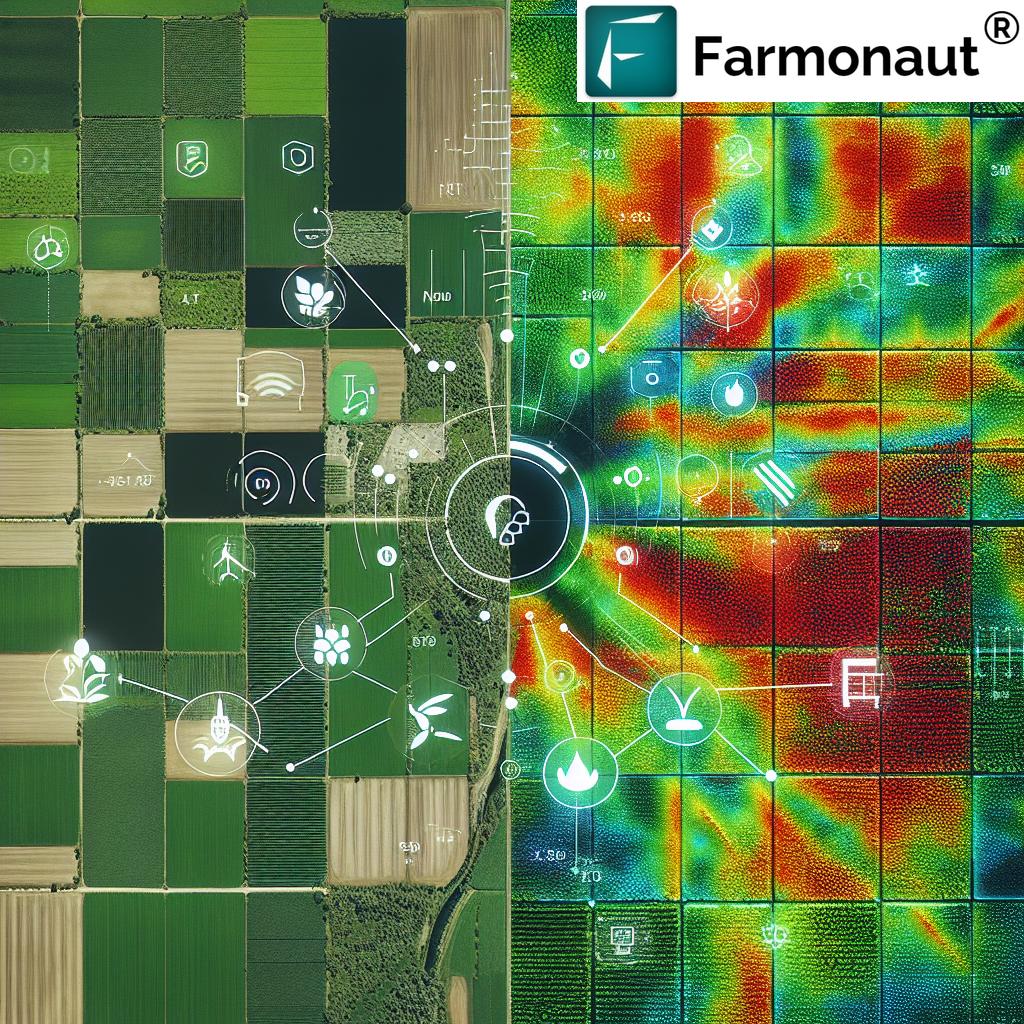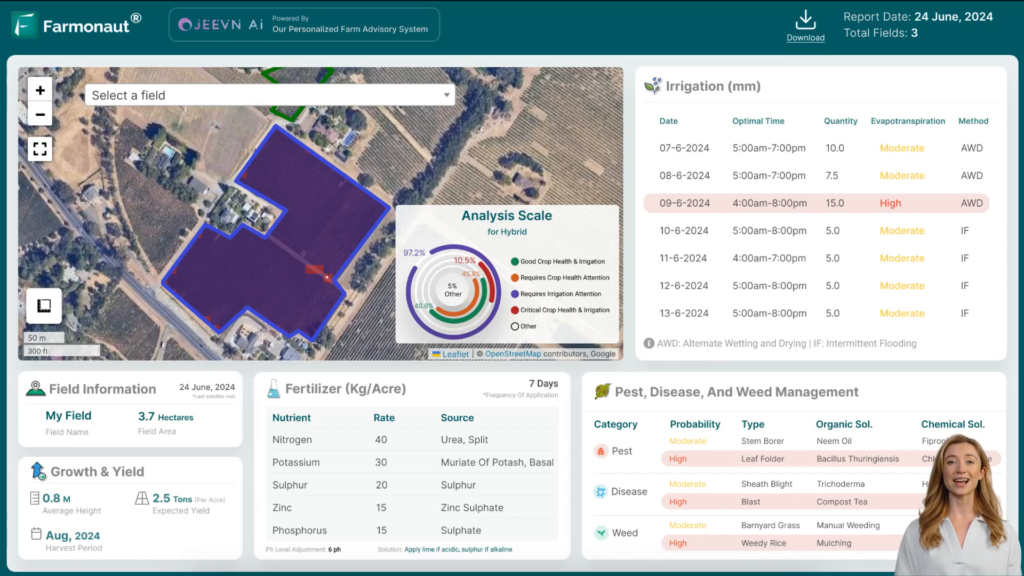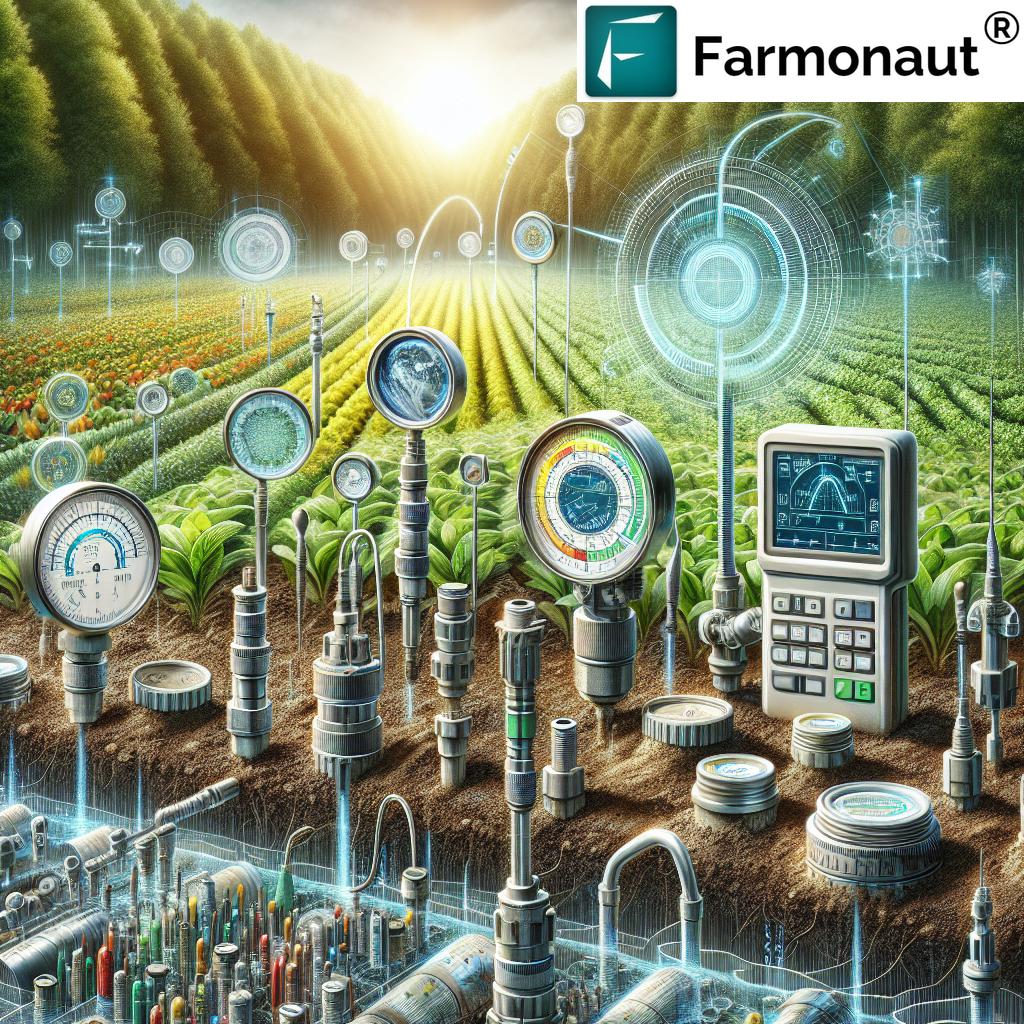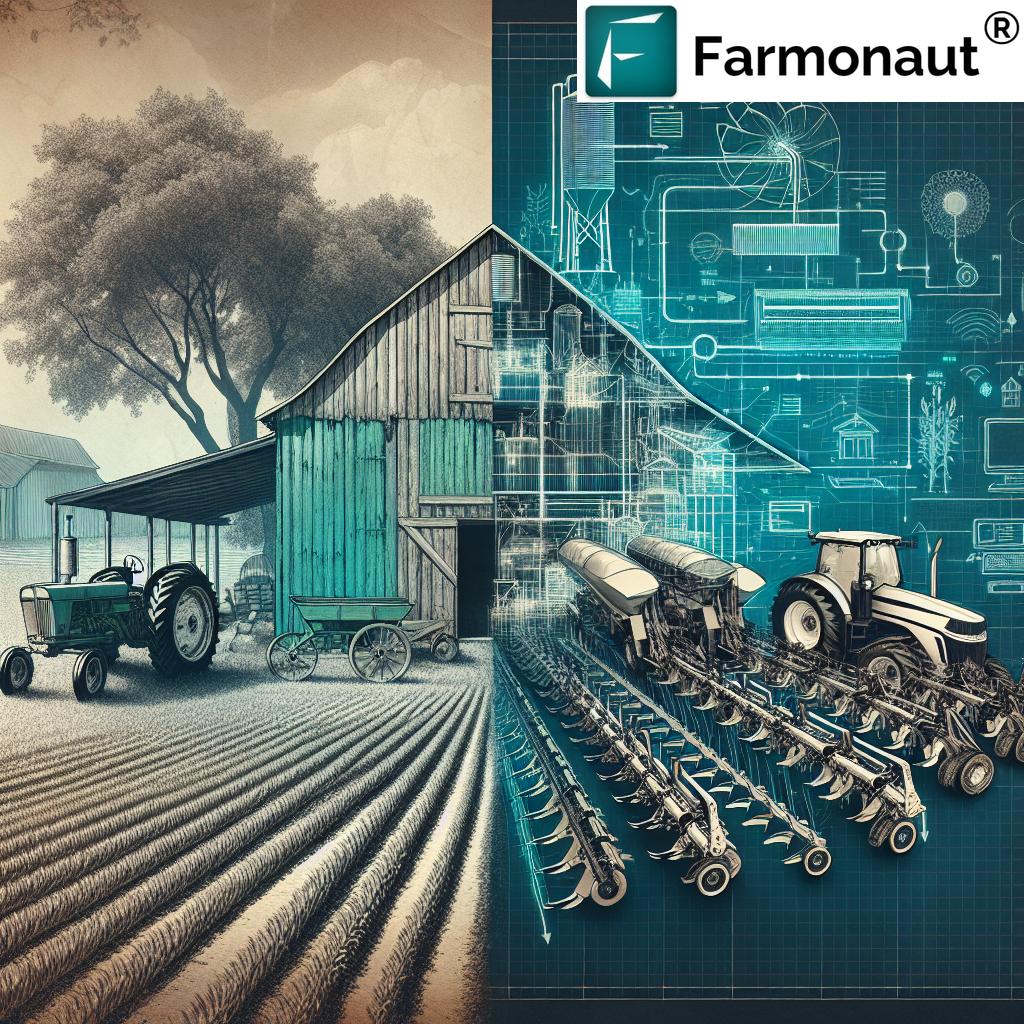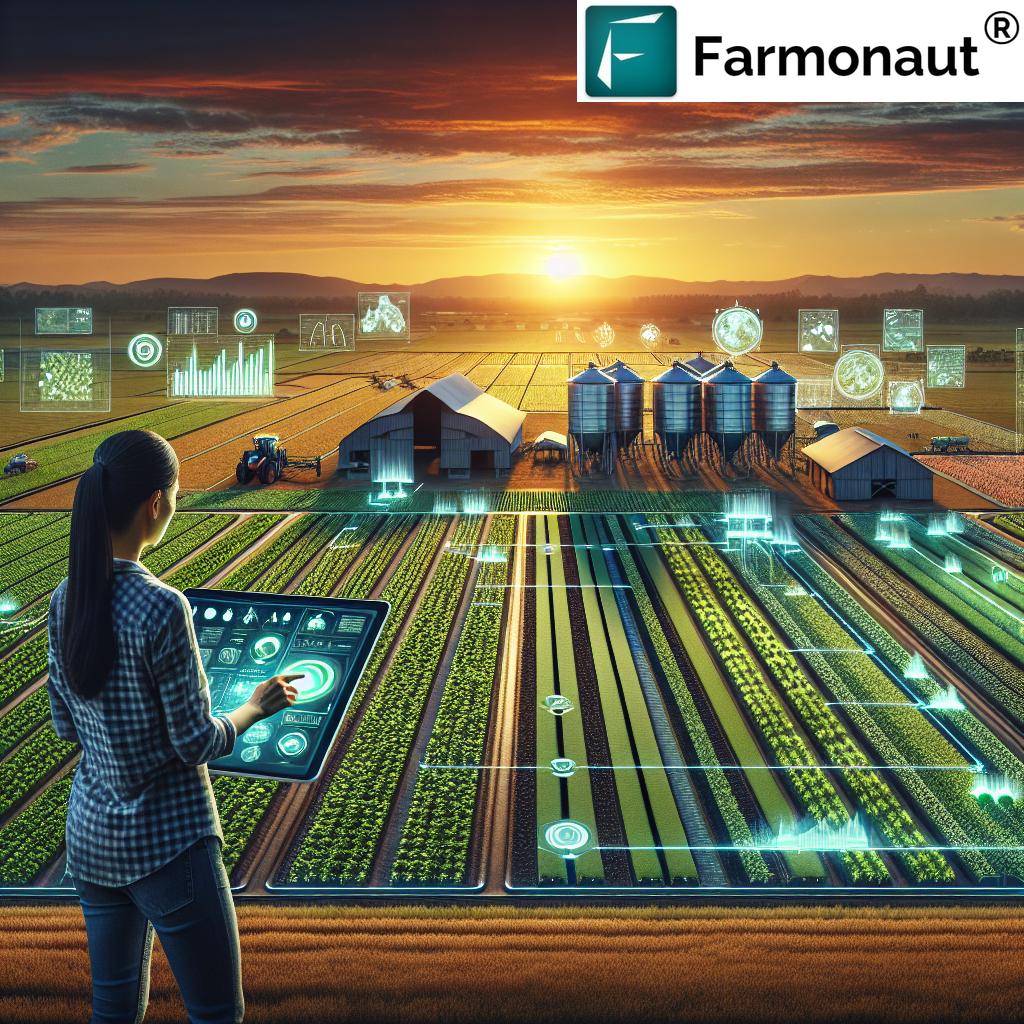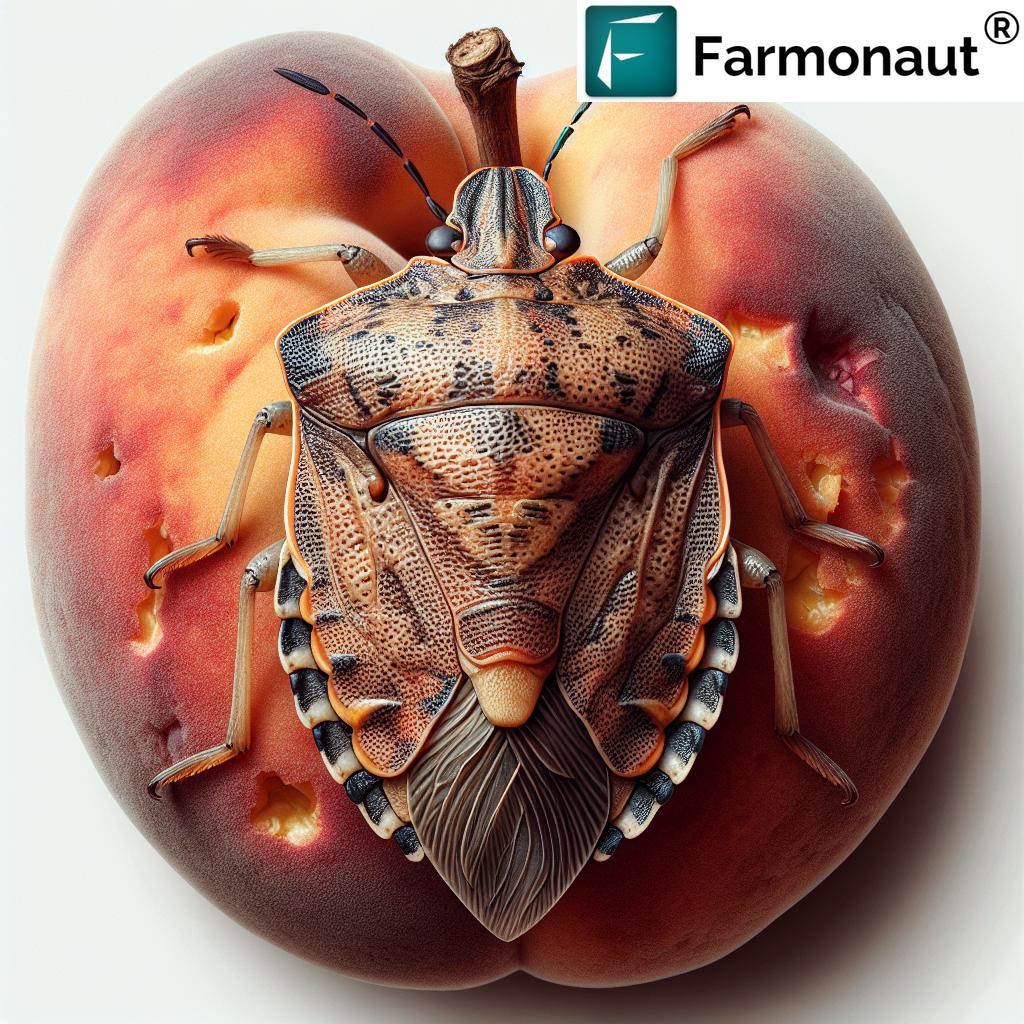Table of Contents
- Introduction — The Technological Shift in Modern Agriculture
- Precision Agriculture: Data at the Root of Productivity
- Agricultural Robotics: Automating Labor-Intensive Tasks
- Artificial Intelligence & Machine Learning in Farming
- IoT Sensors and Smart Farming Technology
- Remote Sensing & Crop Monitoring with Drones
- Automated Irrigation Systems: Efficient Water Management
- Integrating Renewable Energy in Agriculture
- Smart Greenhouses: Controlled Environments for Crops
- Blockchain in Agriculture: Transparency & Trust
- Agrivoltaics: Solar Power Meets Agriculture
- Aeroponics: Soil-less Solutions for Urban Farming
- Automated Livestock Management: Animal Health & Efficiency
- Agriculture Data Analytics for Smart Decision Making
- AI-Powered Chatbots for Farmer Support
- Autonomous Farming Equipment: The Future of Farm Operations
- Comparison Table: Modern Farming Technologies
- Advanced Farm Management Solutions by Farmonaut
- Farmonaut Subscription Plans
- Conclusion: Embracing Farming Innovation for the Future
- Frequently Asked Questions (FAQs)
Modern Technology Solutions for Farmers: Top Innovations
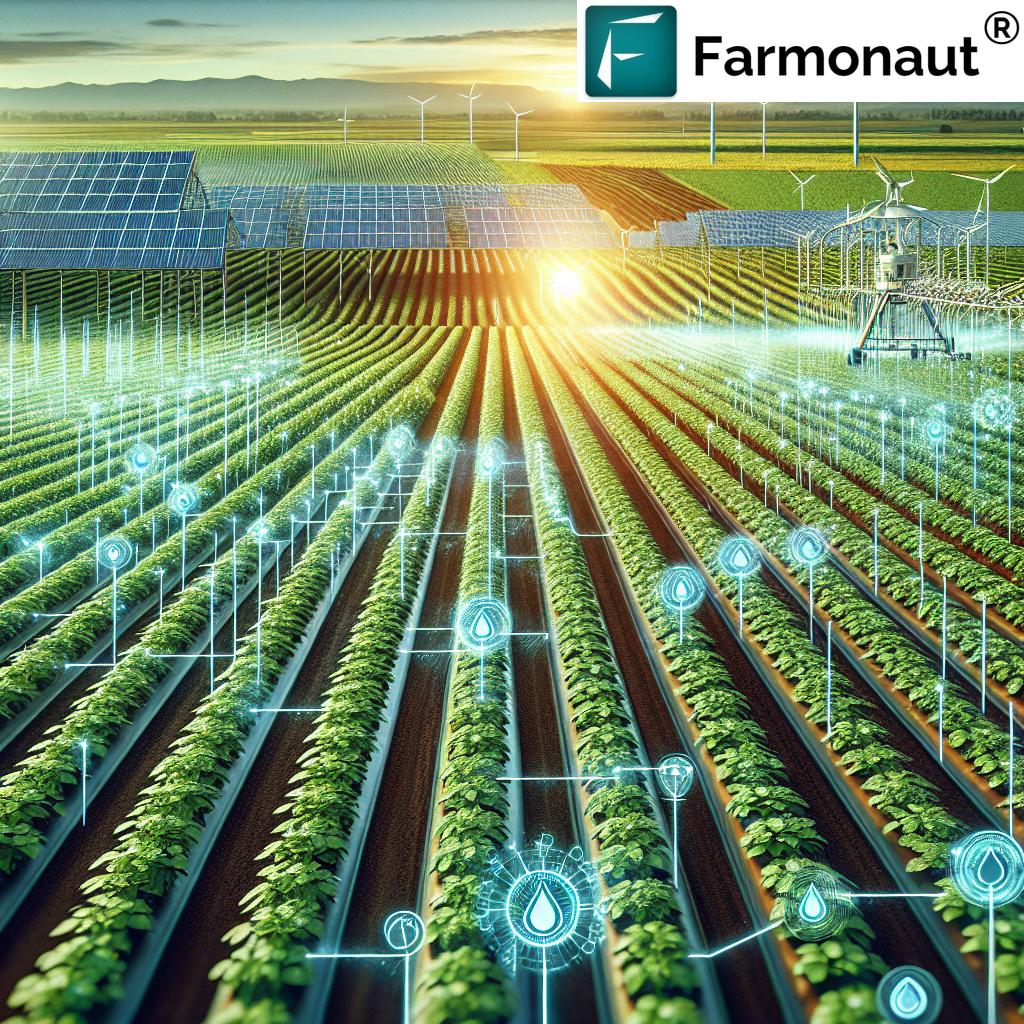
“Precision agriculture can increase crop yields by up to 20% using satellite imagery and data analytics.”
The world of agriculture is undergoing a dramatic technological shift. Driven by global pressures — from labor shortages and resource scarcity to unpredictable climate change — today’s farmers are embracing modern technology solutions that promise enhanced efficiency, superior sustainability, and increased productivity.
We find ourselves in an era where precision agriculture, smart farming technology, and data-driven crop management are no longer distant dreams. These innovations are equipping us with actionable insights, real-time monitoring, and optimized resource usage across our farming operations.
In this comprehensive guide, we’ll explore the top agricultural technology solutions — from autonomous robots and AI analytics to blockchain traceability and renewable energy — that are powering the future of food, fiber, and forestry. We’ll also introduce Farmonaut’s advanced tools, which help make precision agriculture truly accessible to every farmer, agribusiness, and institution.
Precision Agriculture: Data at the Root of Productivity
Precision agriculture is transforming the way we manage our fields. By utilizing technologies such as GPS, IoT sensors, satellite imagery, and data analytics, we can optimize every stage of the farming process — from planting and fertilization to harvesting and monitoring.
- Variable Rate Application: Allows us to apply fertilizers, irrigation water, pesticides, and other inputs exactly where and when they’re needed, reducing waste and maximizing crop yields.
- Field Variability Monitoring: By analyzing soil moisture sensors and satellite data, we can manage field variability and address issues such as pest outbreaks or disease earlier, ensuring optimal growth.
- Data-Driven Insights: With precision farming tools, we no longer rely solely on gut instinct; we use real-time data to make informed decisions about crop management.
Farmonaut advances this vision by providing affordable, satellite-based crop health monitoring. Using its platform, we can access information on vegetation health (see NDVI, NDRE, and other key metrics) and soil moisture, helping us intervene early, optimize resources, and boost productivity.
Key Solutions in Precision Agriculture
- Satellite-based field monitoring for large and small farms
- Soil testing and moisture data to plan irrigation and fertilization
- AI-driven early disease detection systems, enabling targeted intervention
- Fleet and resource management tools — tracking vehicles and farm equipment for operational efficiency (Learn about Farmonaut Fleet Management).
By integrating these modern technologies into our fields, we are not just increasing yields; we are also reducing costs, minimizing waste, and conserving resources — all while enabling smarter decision-making for sustainable agricultural practices.
Agricultural Robotics: Automating Labor-Intensive Tasks
Labor shortages are a significant challenge in modern farming. Fortunately, robotics and automation are stepping in to automate repetitive, dangerous, or labor-intensive tasks such as planting, weeding, and harvesting.
- Robotic Weed Management: Implements powered by AI and machine learning can identify and remove weeds without relying on chemical herbicides, reducing environmental impact and labor costs.
- Autonomous Harvesters and Planters: Machines that follow GPS coordinates, ensuring precise planting and timely harvesting with minimal human intervention, leading to consistent output and improved efficiency.
- Automated Drones: Modern drones are used for spraying fertilizers and pesticides with precision, reducing chemical usage and minimizing worker exposure.
Robust robotics systems offer farmers a way to boost productivity and manage costs in a world where labor is increasingly scarce.
Artificial Intelligence & Machine Learning in Farming Operations
Artificial intelligence (AI) and machine learning are changing the way we use data in agriculture. By analyzing vast datasets — including weather patterns, plant health, soil moisture, and satellite imagery — these technologies help us with:
- Prediction Models: Anticipate optimal planting times, pest outbreaks, and potential yields using sophisticated environmental patterns and historic farm data.
- Field Segmentation: Enable site-specific interventions, targeting only the areas of a field that require irrigation, fertilization, or pest control, reducing resource usage.
- Disease Recognition: With AI-powered image analysis, detect plant diseases or nutrient deficiencies with up to 95% accuracy, prompting early intervention and minimizing losses.
Farmonaut’s Carbon Footprint Tracking leverages such data-driven insights to help us monitor and reduce the environmental impact of our farming operations. This is especially critical for compliance, resource conservation, and sustainability in the agriculture sector.
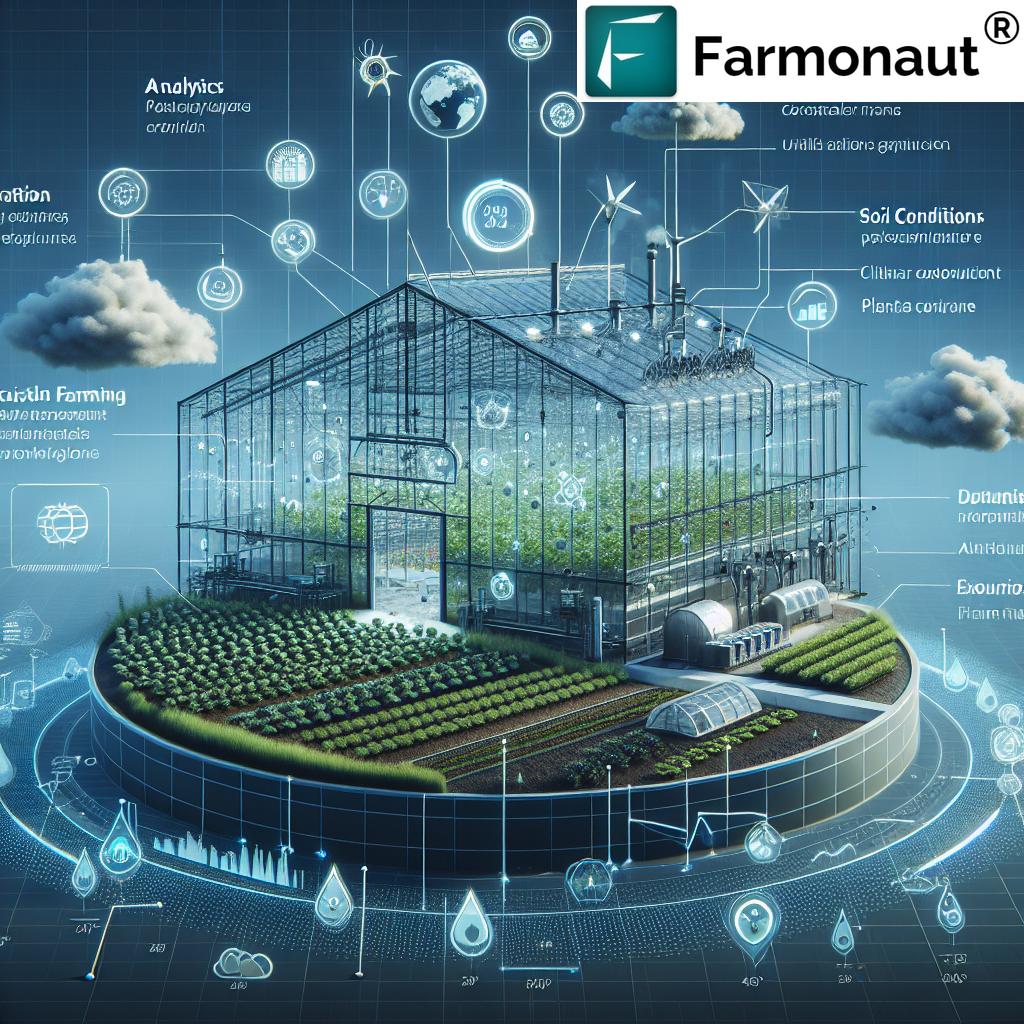
IoT Sensors and Smart Farming Technology for Real-Time Monitoring
The rise of IoT (Internet of Things) sensors has revolutionized smart farming technology. By deploying sensors across fields, equipment, and greenhouses, we gain continuous, granular insights into every stage of crop growth and resource utilization.
- Soil Moisture Sensors: Monitor soil water content in real time, enabling automated irrigation systems that adjust water usage based on crop needs, thus conserving water and boosting yield.
- Environmental Monitoring: Track temperature, humidity, and light levels within greenhouses or open fields, improving plant health and growth.
- Asset Tracking: Use sensors on livestock and farm machinery for fleet management and resource optimization.
“Smart farming technology reduces water usage by approximately 30% through advanced soil and weather monitoring systems.”
Farmonaut’s advanced farm management platform brings all this agriculture data analytics together. By offering real-time monitoring via mobile, web, and API, we can react quickly to changing field conditions and plan resource-saving interventions—from irrigation and fertilization to harvesting.
-
API access for developers: Farmonaut Satellite & Weather API is available, enabling integration into agritech systems and applications.
See API Developer Docs
for system integration and automation.
Remote Sensing & Crop Monitoring with Drones
Drones equipped with multispectral and thermal cameras have drastically improved how we view and manage our fields. They allow us to:
- Quickly scan large areas for plant stress, pests, and early disease — often spotting problems before they’re visible to the human eye.
- Generate high-resolution imagery for mapping variability, tracking crop progress, or assessing storm, drought, or flood damage.
- Reduce pesticide and fertilizer usage by enabling targeted spraying, which minimizes chemical waste and improves safety.
On Farmonaut’s platform, remote sensing and advanced crop monitoring combine to make precision monitoring affordable to every farmer.
Automated Irrigation Systems: Efficient Water Management
In many regions, water scarcity is a major threat to crop yields. Automated irrigation systems empower us to manage water use with precision, minimizing waste and maximizing productivity.
- Remote control of pumps: Using tools like Nano Ganesh, we can remotely switch irrigation pumps on or off via mobile phones.
- Sensor-driven irrigation: Soil moisture sensors eliminate guesswork, automatically adjusting water delivery based on real-time data.
- Scheduling: Automated systems can ensure irrigation at optimal times of day to reduce evaporation and improve resource efficiency.
With automated irrigation integrated into Farmonaut, we access reliable soil moisture analytics and irrigation recommendations for every field, every season.
Integrating Renewable Energy in Agriculture
As concerns over climate change and resource conservation intensify, integrating renewable energy in agriculture has become crucial for both cost savings and sustainability.
- Solar Energy: Power irrigation pumps, storage facilities, and farm buildings with solar panels, cutting operational costs and reducing dependence on fossil fuels.
- Wind Power: In windy regions, wind turbines can provide additional energy for farm operations, complementing solar solutions.
- Off-grid Solutions: For farms outside utility networks, renewable energy can ensure power for automated systems, reducing disruptions and increasing productivity.
Renewable energy integration also supports our transition to more sustainable agricultural practices, reducing emissions and bolstering farm profitability.
Smart Greenhouses: Controlled Environments for Crops
Smart greenhouses use automated climate control systems and IoT sensors to optimize conditions for plant growth. We can:
- Remotely adjust temperature, humidity, and light for each crop type
- Integrate water recycling systems to conserve water and minimize waste
- Reduce pesticide usage through precision monitoring and microclimate management
Farmonaut’s platform allows us to link greenhouse data with satellite and weather analytics for unparalleled climate management and resource planning.
Blockchain in Agriculture: Transparency & Trust
Blockchain technology is revolutionizing how we manage traceability and food safety in agricultural supply chains. Key benefits include:
- Immutable records: Ensure that every step in a product’s journey—from farm to table—is logged securely and transparently.
- Smart contracts: Automate payments and agreements, reducing transaction costs and disputes between farmers, suppliers, and buyers.
- Consumer trust: Verifiable supply chains enable brands to demonstrate sustainable and ethical sourcing, building brand equity.
With Farmonaut’s blockchain-based product traceability, we gain top-tier transparency and security — particularly valuable for food, textile, and sensitive crop supply chains.
Agrivoltaics: Solar Power Meets Agriculture
Agrivoltaics is the innovative practice of installing solar panels above crops or livestock, creating a system that dual-purposes land for both energy generation and agriculture.
- Maximize Land Use: Farms can generate renewable energy while continuing agricultural operations.
- Protect Crops:** Solar panels provide shade, reducing water evaporation and protecting plants from extreme weather.
- Additional Income: Energy harvested can be used on the farm or sold back to the grid, diversifying revenue streams.
Agrivoltaics exemplifies resource optimization and is at the frontier of sustainable agricultural practices.
Aeroponics: Soil-less Solutions for Urban and Modern Farming
Aeroponics allows plants to grow suspended in air, with roots misted regularly with a nutrient solution. This technology is ideal for urban agriculture and regions with limited arable land.
- Resource Efficiency: Uses up to 95% less water than conventional agriculture, reducing waste and costs.
- Space Optimization: Enables vertical farming systems, maximizing yields per square meter.
- Boosted Growth: Accelerates plant growth cycles and supports year-round production for food security.
Integrating aeroponics with smart sensors and AI ultimately leads to precision agriculture landscapes, whether in cities or traditional farms.
Automated Livestock Management: Animal Health and Efficiency
The livestock sector has benefited from automation and IoT tech, helping us streamline operations and improve animal welfare:
- Wearables & Sensors: Monitor animal health, location, and stress indicators in real time, enabling early intervention for disease or discomfort.
- Automated Feeders: Deliver precise amounts of feed, reducing waste and optimizing growth.
- Health Analytics: Data-driven livestock management systems increase profitability while maintaining ethical, sustainable agricultural practices.
Effective livestock management enriches farm productivity and animal security, enhancing total farm profitability.
Agriculture Data Analytics for Smart Decision Making
With the explosion of agricultural data — from field sensors, weather stations, and equipment — analytics is now central to farm management.
- Yield Forecasting: Use historical and real-time data to accurately predict crop yields.
- Market Intelligence: Analytics inform marketing decisions and price timing, optimizing profitability.
- Resource Allocation: Optimize irrigation, labor, and fertilization based on predictive models and data-driven recommendations.
Farmonaut offers a powerful suite of analytics tools for all farm sizes and business needs, centralizing actionable insights for every step of the crop cycle.
AI-Powered Chatbots for Farmer Support
AI-driven chatbots are leveling the knowledge gap for farmers by providing:
- 24/7 support in multiple languages for advice on crop management, irrigation schedules, fertilization, and disease identification.
- Democratized access to regenerative farming practices via instant messaging platforms (WhatsApp, etc.) — especially valuable for smallholder farmers in rural areas.
These smart tools enable us to access timely advice, empowering data-backed decision-making.
Autonomous Farming Equipment: The Future of Farm Operations
Autonomous machinery, such as self-driving tractors and robotic harvesters, are fast becoming a cornerstone of modern agriculture. They offer:
- Reliable Performance: Conduct field operations like tilling, planting, or harvesting with high precision and little or no human input.
- Labor Shortage Mitigation: Address labor shortages and reduce risk of human error.
- Data Integration: These systems gather real-time data, supporting analytics and further automation.
We must weigh investment costs and workforce adaptation but, in the long run, autonomous farming equipment can greatly boost both efficiency and yields.
Comparison Table: Modern Farming Technologies
| Technology | Primary Function | Estimated Yield Improvement (%) | Estimated Cost Reduction (%) | Sustainability Impact | Example Application |
|---|---|---|---|---|---|
| Precision Agriculture Tools | Data-driven management of fields & resources | 15–20% | 10–15% | Reduces fertilizer and water use, minimizes waste | Farmonaut satellite-based crop health monitoring |
| Smart Sensors (IoT) | Real-time tracking of soil, water, crop, livestock | 10–12% | 8–10% | Improves resource use, water conservation | Soil moisture sensors with automated irrigation |
| Drones (UAVs) | Aerial crop scouting & targeted input application | 8–12% | 5–8% | Reduces chemicals, improves safety | Crop monitoring with drones for early stress |
| Data-driven Platforms | Consolidated field analytics & recommendations | 10–15% | 12–18% | Optimizes all resource usage and timing | Farmonaut’s Jeevn AI advisory system |
| Blockchain Traceability | Secure, transparent supply chains | Quality/certification-linked | 4–7% | Reduces fraud, ensures food safety | Farmonaut blockchain product traceability |
| Automated Irrigation | Precision & remote water delivery based on data | 10–15% | 20–30% | Major water savings | Nano Ganesh automatic irrigation |
| Autonomous Farm Equipment | Labor-free planting, cultivation, harvesting | 10–18% | 20–25% | Reduces labor dependence, ensures consistency | GPS-guided tractors and harvesters |
Advanced Farm Management Solutions by Farmonaut
Farmonaut delivers a game-changing suite of technologies for farmers, agribusinesses, institutions, and researchers worldwide:
- Satellite-Based Crop Health Monitoring — Derive weekly, real-time insights on crop stress, vegetation index (NDVI), and soil moisture, visualized across your fields for precision management and early intervention.
- Jeevn AI Advisory System — Personalized, AI-powered crop management strategies, weather forecasts, and expert advisories delivered via app notifications for optimal yields.
- Blockchain Traceability — Transparency for supply chains, ensuring food safety and consumer trust (explore traceability solutions).
- Fleet & Resource Management — Optimizes your assets for cost reduction and operational efficiency (see Farmonaut Fleet Management).
- Carbon Footprinting — Monitor and minimize your agri-business’s environmental impact in the fight against climate change (dive into carbon footprinting benefits).
- Financing & Insurance Support — Satellite-based verification for crop loan and insurance, making financial access simpler (learn more).
- Scalable Solutions — From smallholder fields to government and NGO-managed programs, Farmonaut’s modular approach delivers precise, cost-effective insights anywhere on earth (large-scale management tools).
See it in action via:
Farmonaut’s Mobile & Web App
Farmonaut Subscription Plans
Farmonaut offers affordable, flexible subscription tiers for every need — from solo farmers to agribusinesses and institutions. No expensive hardware, no hidden costs — just actionable satellite data, analytics, and smart management tools.
Get started on your journey to data-driven, sustainable farming today!
Conclusion: Embracing Farming Innovation for the Future
The integration of modern technology solutions into agriculture is reshaping our world, empowering farmers to tackle challenges — from labor shortages and climate unpredictability to maximizing revenue and sustainability. With advances in precision agriculture, smart sensors, AI, and blockchain, we have the tools, systems, and data analytics to pursue optimal yields and ecological responsibility.
Whether addressing issues at the field, farm, or supply chain level, solutions like Farmonaut are making advanced analytics and data-driven crop management accessible to all. By embracing these technologies, we can ensure food security, drive sustainable agricultural practices, and secure a more resilient future for our farming communities.
The agricultural revolution is here. Let’s grow smarter, together!
Frequently Asked Questions (FAQs)
What are the benefits of precision agriculture?
Precision agriculture leverages data analytics, GPS, IoT sensors, and satellite imagery to help us apply fertilizers, irrigation, and pesticides exactly where needed. The payoffs? Higher yields, reduced input costs, and minimized environmental impact—all leading to smarter, more efficient farm management.
How do automated irrigation systems improve water use?
Automated irrigation systems use soil moisture sensors to monitor real-time soil water levels and automatically adjust irrigation schedules. This ensures that crops receive the exact amount of water they require, eliminating waste and conserving precious water resources.
Can smallholder farmers access Farmonaut’s technology?
Yes! Farmonaut’s goal is to make precision agriculture affordable for all. Its modular platform is designed for farms of every size. With mobile and web-based access, even smallholder farmers can monitor crop health, manage resources, and boost yields using cutting-edge satellite and AI tools.
What is blockchain and how does it support sustainable agricultural practices?
Blockchain is a digital ledger that records every transaction securely and transparently, making it impossible to alter past records. In agriculture, it supports traceability, ensuring the authenticity of food supply chains and verifying that sustainable practices are followed from the field to the consumer.
How do I get started with Farmonaut’s tools?
You can sign up on the Farmonaut web or mobile app, or explore our API and developer docs for system integration. Subscription plans are available for every user group.





